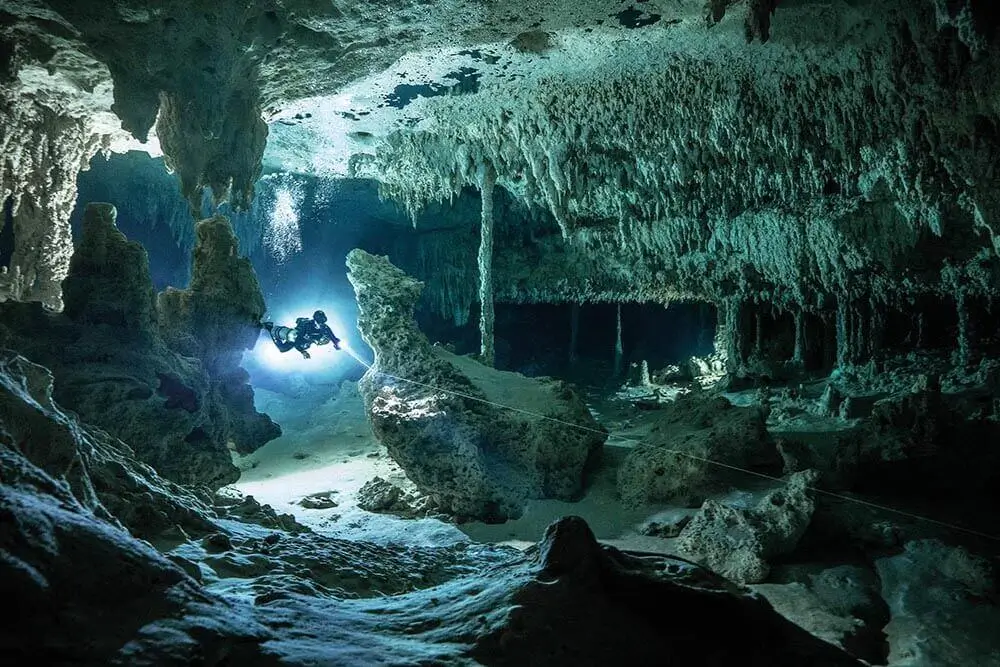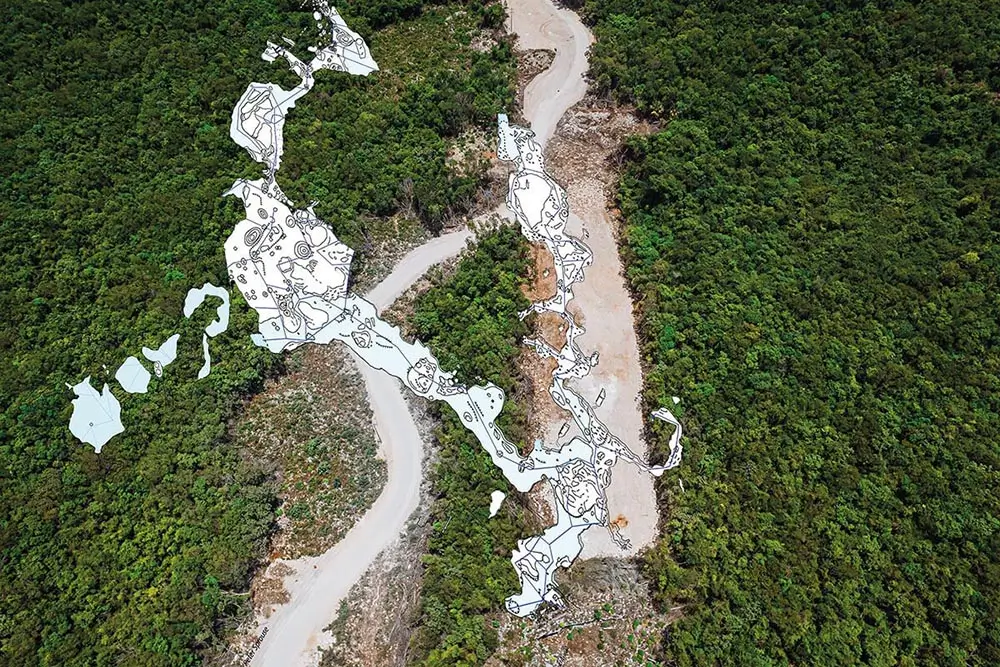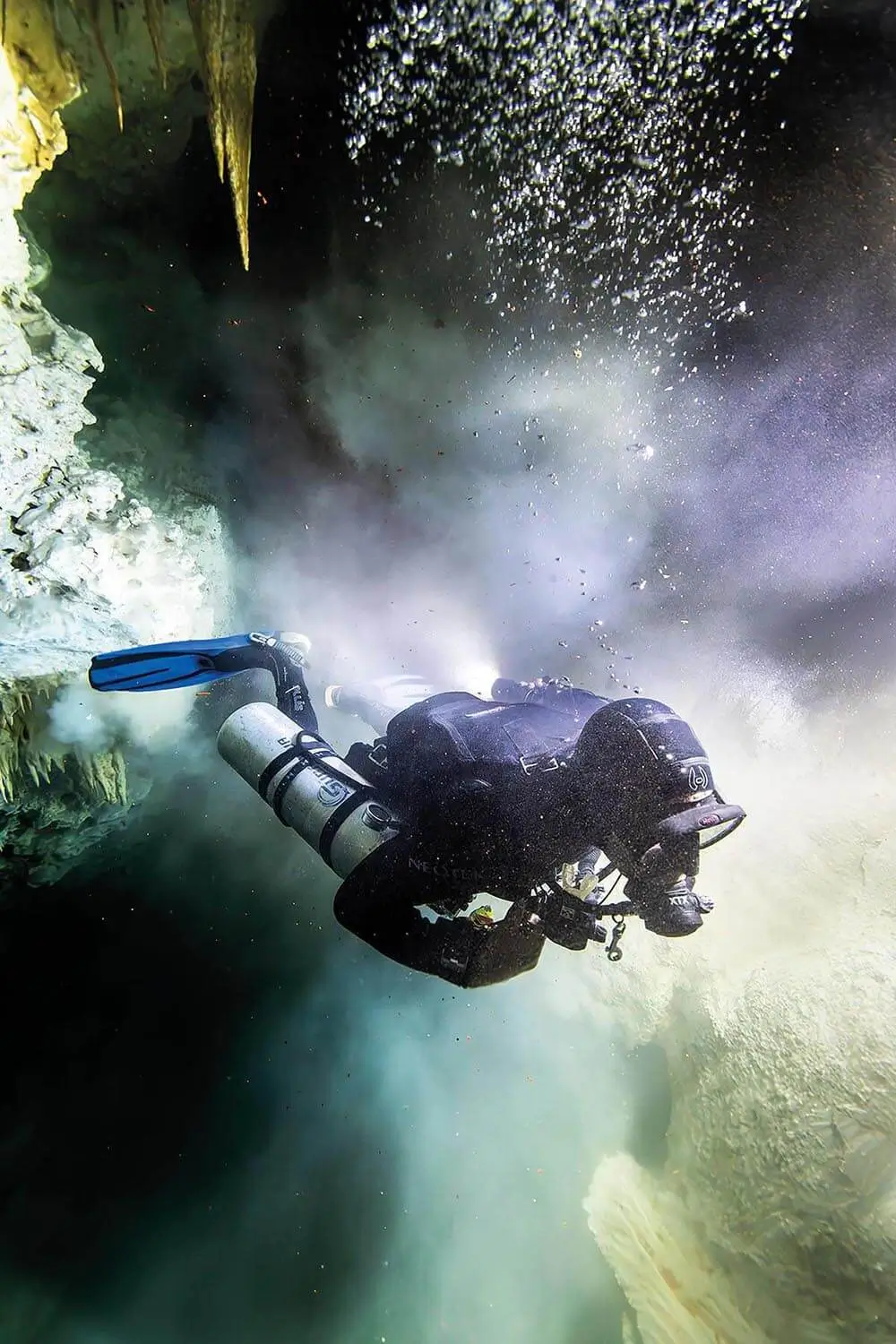
One of the world’s natural wonders is being extensively damaged by the construction of a railway line, as Mexico’s ‘Mayan Train’ is driven through the Yucatán jungle
In December 2019, a referendum overwhelmingly approved the construction of a 1,554-kilometre railway – Tren Maya, or the ‘Mayan Train’ – through the jungles of Mexico’s Yucatán Peninsula, a 120km section of which – Section 5 South – would pass directly over the famous Sac Actun-Dos Ojos cave system, the second-longest known underwater cave system in the world, and Mexico’s largest freshwater aquifer.
In reality, less than three per cent of the more than 3.5 million people entitled to vote in the states of Chiapas, Tabasco, Campeche, Yucatán and Quintana Roo took part. The referendum, which promised that the train would bring nothing but benefits and work to Mexico’s deprived indigenous communities in the region, was deemed illegal under international law.
Despite a short-term reprieve handed down by the courts, Mexico’s then president Andrés Manuel López Obrador pushed ahead with Tren Maya; its construction and operation managed by the military and funded by tourist taxes to the tune of 120 billion Mexican pesos – around US$7.2bn.
As of 2024, however, the monetary price is pushing almost four times its initial budget to around $28.5bn, while the environmental price both short- and long-term, is turning out to be far, far higher.

Having broken ground in 2020, the first portion of the train between Campeche and Cancún is already in operation – and oversubscribed. López Obrador’s government had been pressing for an early completion of Section 5, presumably in part due to this year’s presidential elections.
On 2 June he was replaced by Mexico’s first female president, Claudia Sheinbaum, who styles herself as an environmentalist but is, essentially, López Obrador’s chosen successor. In the week preceding the election, Sheinbaum reportedly met with the leaders of Guatemala and Belize to discuss extending the train into Central America.
Most divers will be aware of the cenotes – sinkholes – for which Yucatán is famous. There are more than 10,000 dotted around the peninsula – some are little more than holes in the ground; others are doorways into the most spectacular limestone cathedrals, filled with a growth of stalactites and stalagmites formed over millions of years, and virtually untouched by the modern human hand.
Those more familiar with the cave system, particularly the cave divers who spend their time exploring its depths, will be aware of how much more the cenotes are worth than being simply attractive, picturesque spots to go for a plunge.
The devastation being wrought by the train’s construction – to both the cenotes and the jungle surrounding the track – is only part of the problem, and may lead to unfathomable destruction further down the line.

The cenotes visited by recreational divers offer just a tiny glimpse into the complex of caves beneath the peninsula; small openings from the surface into the depths of a massive freshwater aquifer permeating the karst below. Created as rock made from soluble minerals such as limestone gradually dissolves and precipitates out of solution, karst structures are in a permanent state of flux. Consequently, the cenotes lead to a complex of interconnections we have barely even begun to uncover.
Exploration is dangerous, time-consuming and limited to a small group of specialist cave divers who have the knowledge and skills to swim through kilometres of narrow cave systems knowing that even minor mistakes could mean death.
Sistema Sac Actun, one of the best-known parts of the complex, is a perfect example of how little we still know. Expeditions to explore the limits of Sac Actun began in 1987 and, until around 2011, it was thought to be the longest underwater cave system in the world, at around 230km in length.
The record would be temporarily superseded by the Ox Bel Ha system, until 2018, when it was discovered that Sac Actun was connected to the Dos Ojos system, extending the record-breaking overall length to 386km. Until 2023, that is, when Ox Bel Ha once again claimed the crown with 435.8km of its length now measured.
There is clearly much more to be explored, and the evolution of autonomous technology will undoubtedly enable us to travel further. It’s likely the records will not stand, and speculation that the entirety of the cave system is connected at some level would not be nonsensical. An expedition in December 2023 found that the Taam Ja’ Blue Hole, a massive sinkhole located to the south of the Yucatán peninsula in Chetumal Bay, was at least 420m deep and with no bottom in sight. Analysis of the water in its depths showed that it is connected to the Caribbean Sea, almost certainly through the same karst structures in which Sac Actun, Dos Ojos and Ox Bel Ha are formed.

The interconnected systems of the Yucatán aquifer create one of the foremost problems that the Tren Maya entails for the environment. Any pollution that enters through the damage caused by the railway’s construction and operation will end up flowing through the system, until it reaches the coral reefs that surround the coastline of Quintana Roo, from Cancún to Playa del Carmen, and perhaps offshore to the island of Cozumel.
Karst is not a solid foundation on which to build infrastructure, and so in an attempt to prevent a future collapse – and, allegedly (and ironically) minimise damage to the cenotes – the engineers are driving pilas, batteries of steel and concrete pillars, into the ground to raise and support the weight of the track and its trains.
It is estimated that between 15,000 and 17,000 concrete pillars, each surrounded by a steel cylinder sleeve acting as a mould while the concrete sets, have already been driven to a depth of around 25m into the aquifer.
A DISASTER WAITING TO HAPPEN
Cave diving instructor Pepe (José) Urbina and Water Treatment Consultant, Guillermo D Christy, are two of the most vocal opponents of the railway, part of a campaign group known as Cenotes Urbanos, in turn part of a larger movement known as Sélvame del Tren (Save Me From the Train) – a play on the Spanish words salva, meaning ‘save’ and selva meaning ‘jungle’.

Together, the campaigners are dedicated to preventing as much future damage as possible from the train line, given that halting its construction now seems impossible at the speed it is being rushed through.
‘The way they are building the train benefits the train, not the environment,’ said Urbina when we spoke. ‘The pillars they know are going to leak concrete, and the concrete is going to spill into the aquifer – and they don’t care.’
The vast number of support columns being drilled into the karst is an attempt to engineer a solution to prevent a catastrophic collapse under the weight of a passing train – because there is no guarantee any individual pillar will sit on solid ground.
‘The cave system here is in continuous collapse,’ says Urbina. ‘They drill a hole and they put the [steel] cylinder in the structure and they fill that with concrete. The problem with that is that for 200m – maybe more – under the limestone you will not find ground underneath. It’s another cave. That’s why they need so many pillars, they are putting in a bed of nails.’
He showed me a video of what happens to concrete that leaks into the water. It never solidifies and even the slightest disturbance creates a cloud in the water column. ‘When you touch the concrete, it goes up, then it’s like you’re diving into a wall – you can see nothing,’ he says.

‘And all of that is moving with the current, and eventually will find its way to the whole aquifer, and of course to the mangrove, and eventually the reef. And this is not an isolated event, this is happening pretty much everywhere.’
The steel sleeves used in the piles’ construction are already corroding and the gradual shedding of rust – multiplied 17,000 times – is just the beginning of the environmental problems posed to the cenotes and the Mexican aquifer.
‘There is already evidence that steel is corroding and we do not know the consequences of pouring concrete directly into the aquifer’, says Christy. ‘Already, around the batteries, some conditions are changing. Some of the cenotes have already reported a change in water clarity due to the drilling.’
‘Although the turbidity eventually settles, it is a clear sign that what happens along the train line will affect these cenotes and the coast,’ he adds. ‘The government talks about transporting cargo with this train and states that 80 per cent will be hydrocarbons from Petróleos Mexicanos.
‘Let’s imagine what a diesel or gasoline spill could be like on the train line. Everything that permeates the jungle eventually reverberates downstream, to the coast, affecting its passage, jungle, mangrove, underground rivers and reef.’
Irreversible damage to individual cenotes – many of them small and unknown to the diving community – is already widespread. Some of the sinkholes and the caves below them have been filled with stone, others are perforated with the pillars of concrete and steel. Others have perhaps not been as extensively damaged to begin with, but may deteriorate over time.
‘For the caves and cenotes, there are different effects from the moment they lost the vegetation cover over them,’ says Christy. ‘The temperature and humidity are altered. These perforations could also affect the flows of fresh and salt water.’

HUMAN REMAINS
The environmental consequences of the railway’s construction are self-evident, but the cenotes are also an important source of evidence broadening the understanding of our own species’ evolution. During the last glacial maximum some 22,000 years ago, global sea levels were around 120m below today’s. Yucatán and its surrounds were above ground, dry, and – as has been discovered in recent years – home to early human civilisations.
The presence of human remains and artefacts in the cenotes – through accident, burial and, apparently, ritual sacrifice – has been well documented. However, the earliest research was necessarily conducted in relatively well-exposed locations, such as the famous, and large, Sacred Cenote of Chichen Itza. It is only in the past 25 years, thanks to advances in cave diving, that properly preserved remains have been discovered deeper into the system – and they forced a rethink as to the timing of when the first humans reached the Americas.
‘The area of Section 5 South is the site with the highest concentration of caves in the state of Quintana Roo,’ says Christy. ‘In this area, the ten oldest bones on the American continent have been recovered, as well as palaeontological pieces from the Ice Age.
‘The geological information that this place houses is of incalculable value when recording climatological information from the history of the Earth. How much information, human, archaeological and palaeontological remains, have been lost with the illegal passage of this work? We will never know.’

A DISMAL FUTURE
Barring some major collapse which, given the rapid manner of its construction, could happen, the completion of the railway tearing a 121km-long, 70m-wide scar through the Mayan jungle seems inevitable. However, it is only the beginning of the trauma that will be inflicted upon the cenotes.
Despite promises that not a single tree would be felled for its construction, an estimated ten million have so far been cut down to make way for a railway that was supposed to run along the coast, not through the jungle. Tren Maya’s original route was planned to follow Highway 307, the coastal road between Cancún in the north and Chetumal in the south, but protests from hotel owners along the route – who would have had to surrender 17-20m of land to the railway and endure the noise of its construction – saw them broker a deal with the federal government to move the railway several kilometres inland.
Its distance from the coast makes the train almost useless as a transport option for many Mexicans seeking employment in the tourist resorts – unless, that is, a wider transport network is built alongside it to ferry people from the train to the resorts. Much development has already been approved, and much land along the railway’s length has already been purchased – or expropriated – meaning more jungle will be cleared and more cenotes will be destroyed.

Increased development will bring more pollution to be deposited into the cave systems, which may have knock-on effects as far as the southern Caribbean. Also, beyond the damage caused during construction, the expansion of the tourist industry along the railway and the influx of people arriving to service it will place more and more demands on the aquifer.
‘The water that this new population will require is approximately the same volume of water that is already being extracted from the aquifer,’ says Christy. ‘We will be (and already are, in fact, in some points such as Tulum), in a process of water stress.
‘We will run out of fresh water due to excess extraction; the intrusion of seawater will salt the wells. The growth of tourism, real estate developments and infrastructure will degrade everything for which tourists come to visit the coasts of Quintana Roo.’
‘It is “Acapulquización”‘, he says, referring to the decay through greed of the once great celebrity resort of Acapulco. ‘We are killing the goose that lays the golden eggs.’
- Don’t shop – dive! ‘Blue Friday’ celebrates its fifth birthday - 21 November 2025
- Suunto launches new Nautic & Nautic S dive computers - 18 November 2025
- Generations Below – a father-son team working to build a global underwater treasure hunt - 11 November 2025
More great reads from our magazine
- Underwater photographer Valentina Cucchiara: doing it with passion
- Working Together- Mexico’s bull shark dives
- Nitrogen Narcosis – beware the rapture of the deep
- Fiji’s Pacific shark feeding boom
- The ride of your life! Scootering with Maldives grey reef sharks



